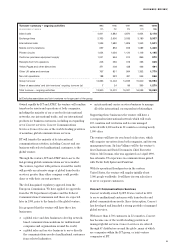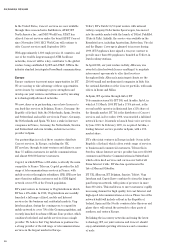BT 1999 Annual Report Download - page 20
Download and view the complete annual report
Please find page 20 of the 1999 BT annual report below. You can navigate through the pages in the report by either clicking on the pages listed below, or by using the keyword search tool below to find specific information within the annual report.
19
BUSINESS REVIEW
support of community activities and programmes are
estimated to bring this up to about 1%. Our Community
Partnership Programme, the largest of its kind in the UK,
concentrates its efforts on education, health and welfare
issues, as well as assisting the arts and disability, and has
a growing focus on supporting the community activities of
BT people. Our expenditure has grown from £10 million
in 1987 to £15 million in the 1999 financial year, including
donations to charity of £2.6 million. No donations were
made to any political party.
Telecommunications has a large part to play in improving
the quality of life of the elderly and disabled. BT spends
£20 million a year to ensure that these customers can get
the most from our products and services. Many of our
products and services are designed specifically to help
overcome disabilities or infirmity: induction loops in
handsets, large button dialpads, amplifiers and loud bells
etc. We also support Typetalk, a teletext service operated
by the Royal National Institute for Deaf People, which
enables people with hearing difficulties to use the phone.
BT and the Millennium
BT is playing a large part in the activities taking place
in the UK to mark the new Millennium. Through a wide-
ranging programme of activities, we plan, under the
FutureTalk banner, to offer everyone in the UK the
chance to improve their skills at interpersonal
communication and make greater use of the
communication technology of the digital age. We
have already distributed nearly two million copies
of TalkWorks, a self-help guide to better everyday
conversations, and will be staging special performances
in thousands of schools throughout the UK. Futuretalk
will have a spectacular presence within the Millennium
Dome in London.
Environment
BT takes its responsibility to the environment very
seriously. We were one of the first major British
companies to produce an environmental policy and
an annual environmental report. We were also among
the first to introduce comprehensive environmental
management systems and to form a policy on sustainable
development. We are confident that we are leading the
way in this area and we have committed BT in the UK to
achieve ISO14001 registration, the international
environmental management system standard,
progressively from March 1999.
BT has a long and widely recognised record of energy
management. We reduced our energy consumption by
more than 13% in the five years to April 1997 and are
now aiming for a further 11% reduction by March 2002.
We have an extensive programme for recycling and
recovering materials, including metal from redundant
exchange units, cables, toner cartridges, office paper
and electronic waste.
BT’s first social report, An issue of responsibility, which
reviews the social impact of BT activities, will be
published shortly.
Education
BT is developing Internet-based services to support on-
line training and education in workplaces and homes.
Solstra, jointly developed by BT and Futuremedia,
provides companies with an enterprise-wide solution to
on-line delivered and managed knowledge, training and
productivity tools. Solstra can deliver learning material on-
line to anyone authorised to receive it, at any time (in any
time zone) anywhere in the world. It is a system with the
potential to deliver training on a global scale.
Education is about more than just technology. BT and its
people offer support and help in many other ways. In
particular, a number of programmes foster links between
education and business, introducing pupils to the world of
work and helping them to prepare for their working life.
Our award schemes provide around £1 million a year to
schools and further and higher education establishments,
enabling a range of innovative projects and the use of new
technology. We also host visits from teachers to raise their
awareness of industry and skills needs. Away from work,
more than 1,000 BT people are school governors.
Regulation, competition and prices
The commercial environment in the UK and in the
countries in which BT operates or wishes to operate
is increasingly competitive and dynamic. However, we
remain subject to extensive regulation, particularly
in the UK, which can materially affect the way in which
the company carries out its business.
Regulation in the UK
The regulatory structure for telecommunications in the
UK is set out principally in the Telecommunications Act
1984, which gives regulatory authority to the Secretary
of State for Trade and Industry and the Director General
of Telecommunications who heads the Office of
Telecommunications (Oftel). The Secretary of State and
the Director General are required to ensure, as far as
reasonably practicable, that demand for telecommunication
services, including certain community services, is met
and to secure the ability of licensed operators to finance
the provision of those services. In addition, they are
























